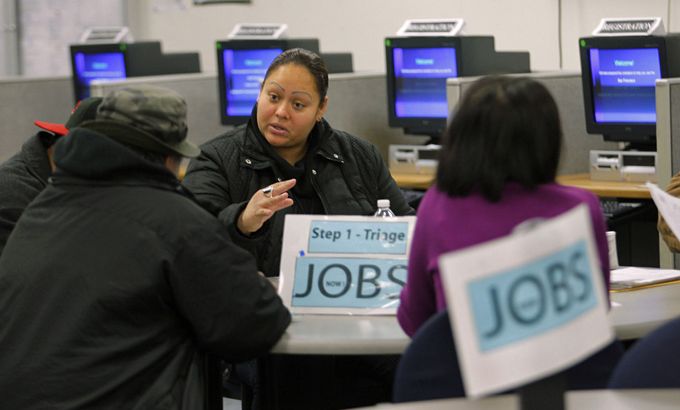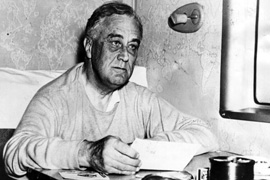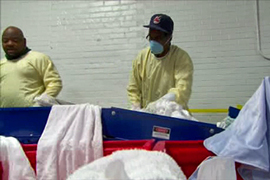
Working through the US jobs crisis
Fault Lines explores Washington’s failure of imagination in dealing with unemployment.
To be unemployed in the US – to lose your identity as a consumer in an economy where 70 per cent of all activity is consumption – is in some way to inhabit another country.
In fact, if you count all the unemployed, underemployed, and those who have given up looking for work in the US, you have a population of almost 30mn – a country about the size of Canada.
Keep reading
list of 4 itemsWhy is Germany maintaining economic ties with China?
Behind India’s Manipur conflict: A tale of drugs, armed groups and politics
China’s economy beats expectations, growing 5.3 percent in first quarter
Economists from both left and right are predicting that unemployment is going to remain at historic levels for years in the US – and the average length of a job search is already at an all-time high of almost eight months.
The political future of Barack Obama’s presidency may hinge on his ability to bring the unemployment rate down. So the question that immediately comes to mind is why he has not yet proposed a single big idea or bold plan commensurate with the scope of the crisis.
There was the stimulus bill, of course, and it has saved more than a million jobs. But the US economy needs to create 10mn jobs just to get unemployment back down to the five per cent level where it was before the financial meltdown began two-and-a-half years ago.
The anxiety of debt
So why the political paralysis?
Firstly, there are the easy answers to this question – the current debt and deficit anxiety that hangs over Washington (conveniently slamming the door on any new ambitious social agenda) results from the roadblock of a conservative Senate beholden to corporate lobbies.
There are also signs that the White House is just playing for time, assuming that the economy will rebound and put people back to work without another intervention from the government.
But what if the real reason is a simple failure of imagination or an inability to think big when it comes to job creation? The last 30 years of political discourse in the US has systematically shrunk the notion of what government is for and what it can do.
Amid the resounding silence from policy-makers on the number one issue facing the country, there are mounting calls for “a new WPA” – a public works programme on the order of former US president Franklin Roosevelt’s Works Progress Administration in the 1930s.
And looking at what was accomplished the last time the US faced an economic crisis of this magnitude, one begins to understand why these calls are getting stronger.
Putting people to work
 |
| Roosevelt’s Works Progress Administration kept many Americans employed [GETTY] |
In 1933, a lunchtime meeting led to the creation of an early New Deal programme – the Civil Works Administration. Two months later, more than four million people were put to work, building roads, bridges, airports – the infrastructure of the modern state.
With a fraction of the money it has put behind backstopping the banks or bailing out the automotive sector, the US government could have created millions of jobs once again.
And it wouldn’t have to be make-work – the country’s infrastructure is crumbling, and the smart grids and high-speed railways of a green future have yet to break ground.
These are all familiar talking points from Obama and yet the economic plan to fund them is missing in action.
Here is the argument: Yes, spending on a massive jobs programme would add to the debt and deficit. But in an economy based on consumer spending, unemployment at current levels is a massive economic burden in its own right.
A recent study found that unemployment from 2008-2012 will cost the economy one trillion dollars in lost wages. Yes, one trillion.
The cost of doing nothing is staggering.
Outside the ideological box
But the Obama administration is clearly not going there. In the meantime, some interesting experiments in job creation are emerging outside the narrow ideological box in Washington.
The state of Mississippi has launched a programme called Steps, which uses money from Obama’s stimulus bill to directly create jobs.
Businesses hire new workers and the government pays the entire salary for the first two months, with gradually declining subsidies over the first six months. The state has engaged 200 employers so far, and in its first two months the programme has created 400 jobs.
And here is a jolt of political vertigo – the Steps programme is being championed by one of the country’s most powerful and conservative politicians, Mississippi governor Haley Barbour.
Barbour had previously said that the Obama administration has “attempted the biggest lurch to the left of any administration in American history.”
It turns out that ideology is negotiable when it comes to the very popular project of creating jobs in the midst of the great recession. There are now 21 states looking to follow Mississippi’s lead on direct job creation with public money.
The Cleveland Model
 |
| The laundry initiative as part of the Cleveland Model has started creating jobs |
On the East Side of Cleveland, Ohio, there is an ever more daring job creation programme taking flight. It is being called “The Cleveland Model”.
It is a cluster of new worker-owned co-operatives, with its flagship the Evergreen Cooperative Laundry, which launched just a few months ago.
It is a state-of-the-art facility that can handle more than 4.4mn kilogrammes of laundry a year from local hospitals and nursing homes. It is a truly green business, which has the capacity to employ 50 workers.
The workers sit on the company board, and participate in decisions about hiring, firing, production and investment.
They pay a small part of their salary back in to the company and over time amass equity. In a few years, a worker-owner at the laundry, while making a modest but living wage, will also end up with a $65,000-stake in the company.
The employees are not just getting salaries, they are building wealth.
In addition to the laundry, there is a solar panel installation business, a greenhouse for lettuce and other salad greens, and a local newspaper. All of these businesses are in various stages of launching and all are on track to create jobs.
“Anchor institutions”
The clients for the co-ops are so-called “anchor institutions” – universities and hospitals that are booming despite the recession.
These facilities spend $3bn a year in goods and services – though little stays in the local economy. The Cleveland Model takes advantage of this built-in market – doing laundry for the hospitals, installing solar panels on the shiny buildings, and so on.
Unlike the precarious manufacturing work that has fled the area in recent years, and unlike the big industries like steel that have also departed leaving much of the city a post-industrial wasteland, these jobs are rooted in the community and are not likely to go anywhere.
However, even its most enthusiastic fans will tell you that the Cleveland Model is by no means a systemic solution for unemployment in the US today. In the short term, this creative experiment will create a few hundred jobs at the most.
But they seem much more significant when considered in light of the failure of imagination and political paralysis in Washington. Before the political will and popular pressure can push the political class into real action on creating jobs, genuine alternatives have to be developed and proven on a smaller scale.
And that is why Cleveland’s co-operators say they are in it for the long haul. They are well aware that the greatest power of their experiment is that it could rekindle a sense of possibility, and rebuild the model of collective action that was so strong in the 1930s, but has gone missing in the post-industrial, consumer-driven US today.
Since Obama’s election, the country has been waiting for him to lead on job-creating.
For supporters of the Cleveland model, all they want him to do is follow.
The investigation on unemployment in the US can be seen on Fault Lines from Thursday, April 8, at the following times GMT: Thursday: 0600, 1630; Friday: 0130, 0830; Saturday: 1130, 2330; Sunday: 0630, 2030; Monday: 1430; Tuesday: 1230, 1930; Wednesday: 0300.